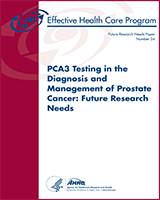| 1 | Information on the comparative performance of PCA3 and currently used biomarkers to detect prostate cancer; “matched studies” on comparators | 1. What is the comparative effectiveness of PCA3 compared with the 2 commonly used add-on tests of fPSA and tPSA velocity/doubling time in predicting prostate biopsy results? | Patients at risk for prostate cancer based on elevated PSA and/or abnormal DRE | PCA3 testing | fPSA and PSA velocity/doubling time | Positive biopsy | Any duration of followup | All settings |
| 2. What are PCA3’s diagnostic performance characteristics in patients with elevated tPSA levels? | Patients at risk for prostate cancer based on elevated PSA and/or abnormal DRE | PCA3 testing | tPSA | Positive biopsy | Any duration of followup | All settings |
| 3. What is the comparative effectiveness of PCA3 compared with externally validated nomograms in predicting prostate biopsy results? | Patients at risk for prostate cancer based on elevated PSA and/or abnormal DRE | PCA3 testing | Externally validated nomograms | Positive biopsy | Any duration of followup | All settings |
| 2 | Studies on how PCA3 actually helps in biopsy or treatment decisionmakinga | 1. What information does PCA3 provide about the aggressiveness of prostate cancer? Do positive results correlate with tumors with aggressive features on biopsy or upgrading of tumors on prostatectomy? Do negative results correlate with tumors that may not require identification or aggressive treatment? | Patients with elevated PCA3 values | PCA3 testing | Current standard of care without PCA3 testing | Features of aggressive tumor on biopsy; upgrading of tumor on prostatectomy | Any duration of followup | All settings |
| 2. Does the addition of PCA3, either alone or in combination with other markers, change prostate cancer biopsy or treatment decisionmaking for the patient or physician? | Patients with PCA3 values available for making decisions about biopsy or about applying active surveillance vs. aggressive therapy | PCA3 testing | Current standard of care without PCA3 testing | Decision to biopsy or wait; decision to initiate aggressive therapy or elect to be followed with active surveillance | Any duration of followup | All settings |
| 3 | Information on impact of PCA3 in biopsy decisionmaking on long-term health outcomes | 1. Does the addition of PCA3 testing change long-term health outcomes in prostate screening? | Patients electing to be screened for prostate cancer using PSA and/or DRE | PCA3 testing | Current standard of care without PCA3 testing | Mortality, morbidity, quality of life | Any duration of followup | All settings |
